

Compact Muon Solenoid
LHC, CERN
| CMS-HIG-21-006 ; CERN-EP-2022-157 | ||
| Search for CP violation in ttH and tH production in multilepton channels in proton-proton collisions at $ \sqrt{s} = $ 13 TeV | ||
| CMS Collaboration | ||
| 4 August 2022 | ||
| JHEP 07 (2023) 092 | ||
| Abstract: The charge-parity (CP) structure of the Yukawa interaction between the Higgs (H) boson and the top quark is measured in a data sample enriched in the ttH and tH associated production, using 138 fb$^{-1}$ of data collected in proton-proton collisions at $\sqrt{s} = $ 13 TeV by the CMS experiment at the CERN LHC. The study targets events where the H boson decays via H $\to$ WW or H $\to\tau\tau$ and the top quarks decay via t $\to$ Wb: the W bosons decay either leptonically or hadronically, and final states characterized by the presence of at least two leptons are studied. Machine learning techniques are applied to these final states to enhance the separation of CP-even from CP-odd scenarios. Two-dimensional confidence regions are set on ${\kappa_{\mathrm{t}}}$ and ${\tilde{\kappa}_{\mathrm{t}}}$, which are respectively defined as the CP-even and CP-odd top-Higgs Yukawa coupling modifiers. No significant fractional CP-odd contributions, parameterized by the quantity ${|{f_{\mathrm{CP}}^{\mathrm{H}\mathrm{t}\mathrm{t}}}|}$ are observed; the parameter is determined to be ${|{f_{\mathrm{CP}}^{\mathrm{H}\mathrm{t}\mathrm{t}}}|} =$ 0.59 with an interval of (0.24, 0.81) at 68% confidence level. The results are combined with previous results covering the H $\to$ ZZ and H $\to\gamma\gamma$ decay modes, yielding two- and one-dimensional confidence regions on ${\kappa_{\mathrm{t}}}$ and ${\tilde{\kappa}_{\mathrm{t}}}$, while ${|{f_{\mathrm{CP}}^{\mathrm{H}\mathrm{t}\mathrm{t}}}|}$ is determined to be ${|{f_{\mathrm{CP}}^{\mathrm{H}\mathrm{t}\mathrm{t}}}|} =$ 0.28 with an interval of ${|{f_{\mathrm{CP}}^{\mathrm{H}\mathrm{t}\mathrm{t}}}|} <$ 0.55 at 68% confidence level, in agreement with the standard model CP-even prediction of ${|{f_{\mathrm{CP}}^{\mathrm{H}\mathrm{t}\mathrm{t}}}|} =$ 0. | ||
| Links: e-print arXiv:2208.02686 [hep-ex] (PDF) ; CDS record ; inSPIRE record ; HepData record ; CADI line (restricted) ; | ||
| Figures & Tables | Summary | Additional Figures | References | CMS Publications |
|---|
| Figures | |

png pdf |
Figure 1:
Representative Feynman diagrams for the ttH production processes. |
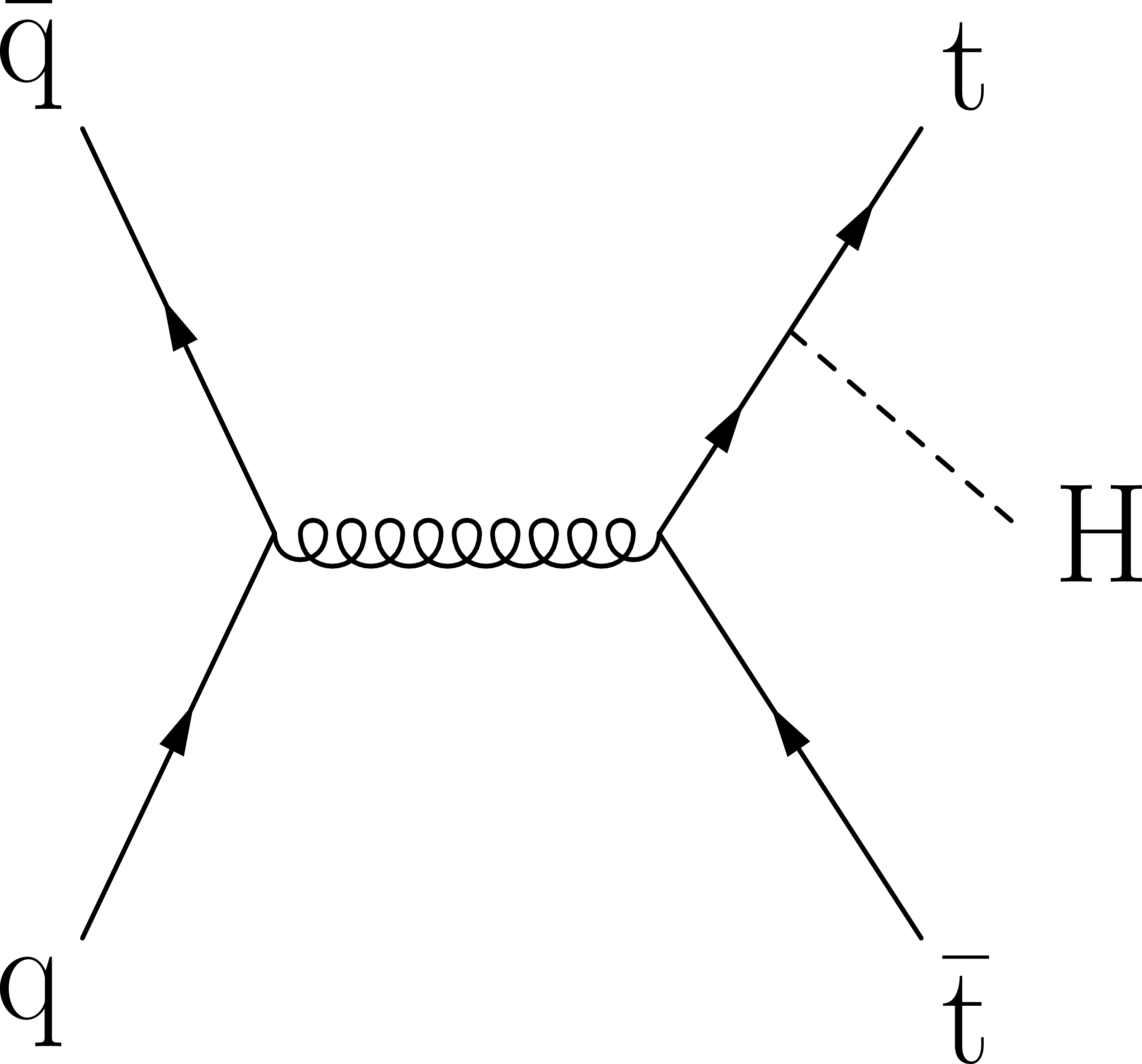
png pdf |
Figure 1-a:
Representative Feynman diagrams for the ttH production processes. |
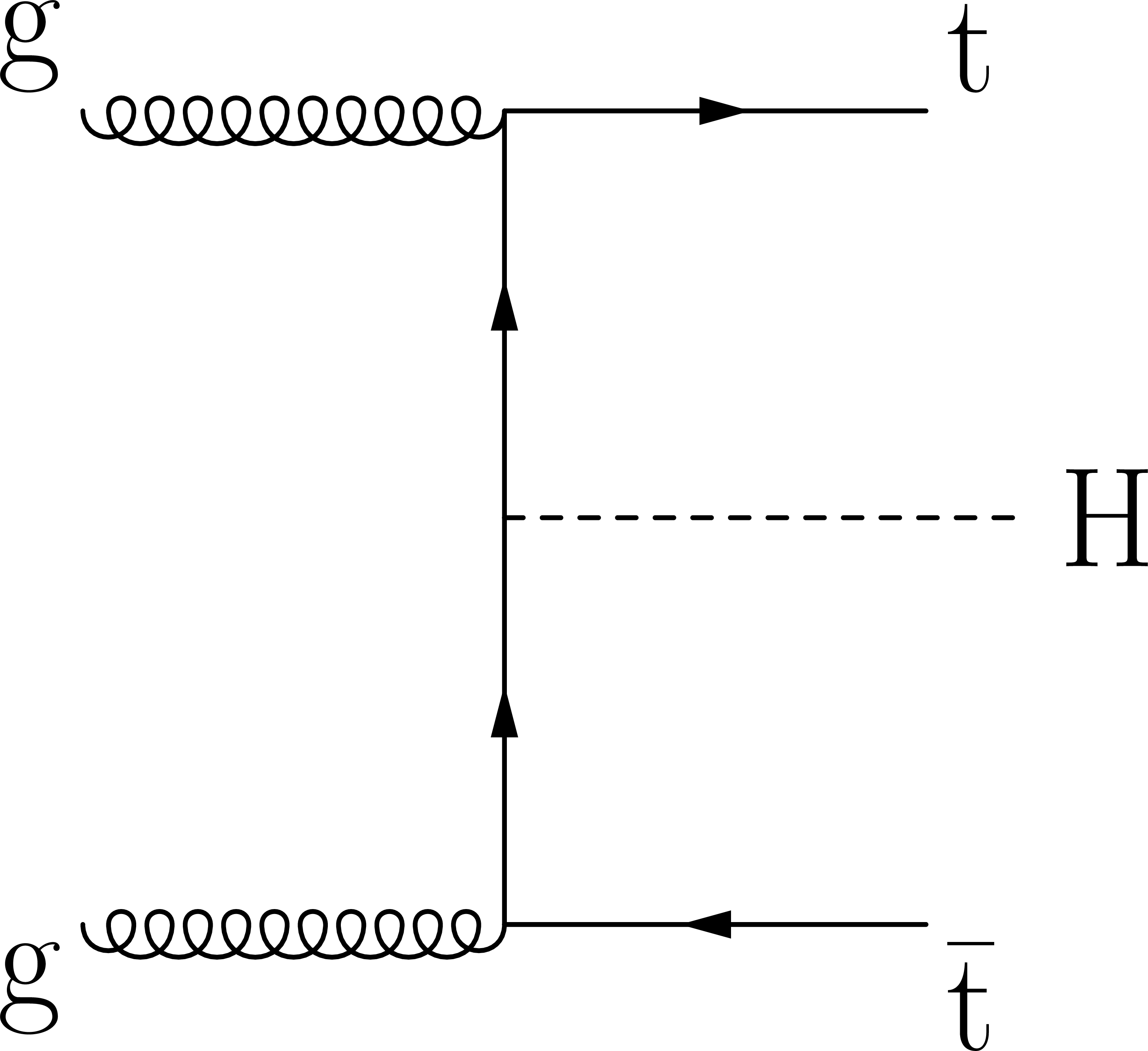
png pdf |
Figure 1-b:
Representative Feynman diagrams for the ttH production processes. |

png pdf |
Figure 2:
Upper (lower) row: representative Feynman diagrams for the tH process in the $ t $-channel ($tW-associated) production mode. |

png pdf |
Figure 2-a:
Upper (lower) row: representative Feynman diagrams for the tH process in the $ t $-channel ($tW-associated) production mode. |
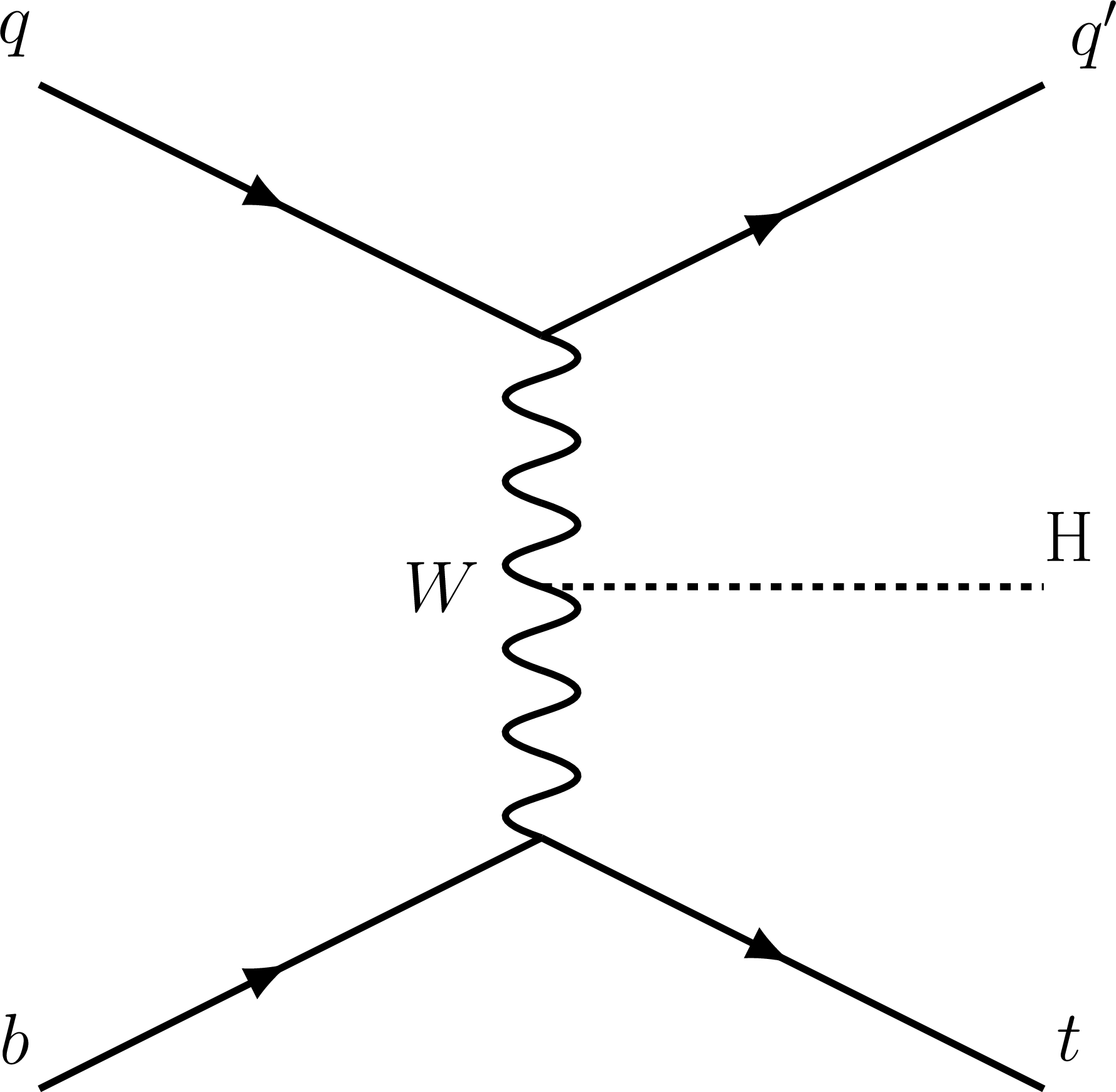
png pdf |
Figure 2-b:
Upper (lower) row: representative Feynman diagrams for the tH process in the $ t $-channel ($tW-associated) production mode. |

png pdf |
Figure 2-c:
Upper (lower) row: representative Feynman diagrams for the tH process in the $ t $-channel ($tW-associated) production mode. |

png pdf |
Figure 2-d:
Upper (lower) row: representative Feynman diagrams for the tH process in the $ t $-channel ($tW-associated) production mode. |
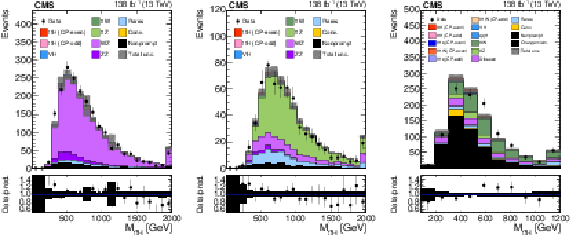
png pdf |
Figure 3:
One of the most important input variables for the CP discriminant, $ M_{\mathrm{t}\overline{\mathrm{t}}\mathrm{H}} $, in the three validation regions enriched from left to right in WZ, ttZ and misidentified lepton background. |
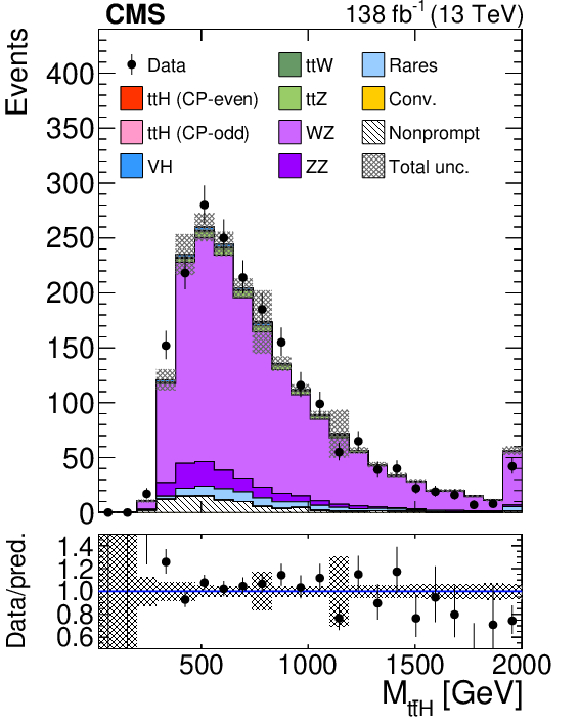
png pdf |
Figure 3-a:
One of the most important input variables for the CP discriminant, $ M_{\mathrm{t}\overline{\mathrm{t}}\mathrm{H}} $, in the three validation regions enriched from left to right in WZ, ttZ and misidentified lepton background. |

png pdf |
Figure 3-b:
One of the most important input variables for the CP discriminant, $ M_{\mathrm{t}\overline{\mathrm{t}}\mathrm{H}} $, in the three validation regions enriched from left to right in WZ, ttZ and misidentified lepton background. |

png pdf |
Figure 3-c:
One of the most important input variables for the CP discriminant, $ M_{\mathrm{t}\overline{\mathrm{t}}\mathrm{H}} $, in the three validation regions enriched from left to right in WZ, ttZ and misidentified lepton background. |

png pdf |
Figure 4:
One of the most important input variables for the CP discriminant, $ \Delta \eta_{BB} $, in the three validation regions enriched from left to right in WZ, ttZ and misidentified lepton background. |

png pdf |
Figure 4-a:
One of the most important input variables for the CP discriminant, $ \Delta \eta_{BB} $, in the three validation regions enriched from left to right in WZ, ttZ and misidentified lepton background. |

png pdf |
Figure 4-b:
One of the most important input variables for the CP discriminant, $ \Delta \eta_{BB} $, in the three validation regions enriched from left to right in WZ, ttZ and misidentified lepton background. |

png pdf |
Figure 4-c:
One of the most important input variables for the CP discriminant, $ \Delta \eta_{BB} $, in the three validation regions enriched from left to right in WZ, ttZ and misidentified lepton background. |

png pdf |
Figure 5:
Most important input variables to the XGBOOST used for CP discrimination in 2$\ell$SS$+$0$\tau_{\mathrm{h}}$ channel, defined in Table 4. The vertical bars represent the statistical uncertainty originating from the limited amount of simulated events. When not visible, the bars are smaller than the line width. |

png pdf |
Figure 5-a:
Most important input variables to the XGBOOST used for CP discrimination in 2$\ell$SS$+$0$\tau_{\mathrm{h}}$ channel, defined in Table 4. The vertical bars represent the statistical uncertainty originating from the limited amount of simulated events. When not visible, the bars are smaller than the line width. |

png pdf |
Figure 5-b:
Most important input variables to the XGBOOST used for CP discrimination in 2$\ell$SS$+$0$\tau_{\mathrm{h}}$ channel, defined in Table 4. The vertical bars represent the statistical uncertainty originating from the limited amount of simulated events. When not visible, the bars are smaller than the line width. |

png pdf |
Figure 5-c:
Most important input variables to the XGBOOST used for CP discrimination in 2$\ell$SS$+$0$\tau_{\mathrm{h}}$ channel, defined in Table 4. The vertical bars represent the statistical uncertainty originating from the limited amount of simulated events. When not visible, the bars are smaller than the line width. |

png pdf |
Figure 6:
Most important input variables to the XGBOOST used for CP discrimination in 3$\ell$SS$+$0$\tau_{\mathrm{h}}$ channel, defined in Table 4. The vertical bars represent the statistical uncertainty originating from the limited amount of simulated events. When not visible, the bars are smaller than the line width. |

png pdf |
Figure 6-a:
Most important input variables to the XGBOOST used for CP discrimination in 3$\ell$SS$+$0$\tau_{\mathrm{h}}$ channel, defined in Table 4. The vertical bars represent the statistical uncertainty originating from the limited amount of simulated events. When not visible, the bars are smaller than the line width. |
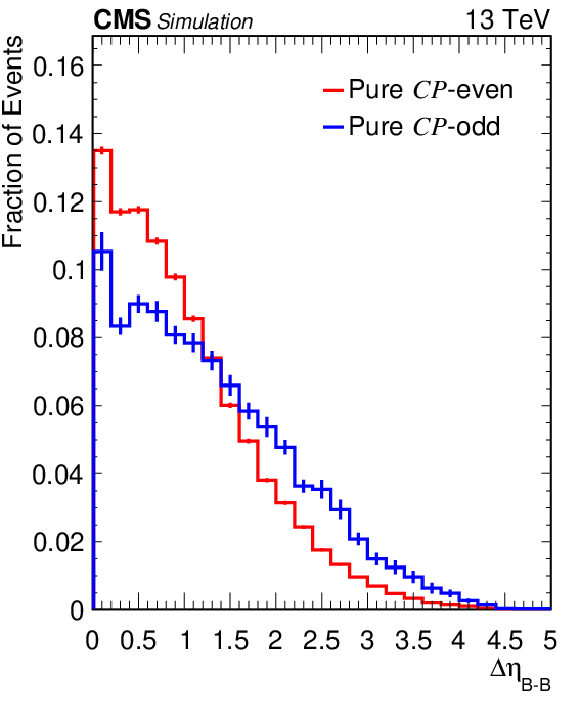
png pdf |
Figure 6-b:
Most important input variables to the XGBOOST used for CP discrimination in 3$\ell$SS$+$0$\tau_{\mathrm{h}}$ channel, defined in Table 4. The vertical bars represent the statistical uncertainty originating from the limited amount of simulated events. When not visible, the bars are smaller than the line width. |

png pdf |
Figure 6-c:
Most important input variables to the XGBOOST used for CP discrimination in 3$\ell$SS$+$0$\tau_{\mathrm{h}}$ channel, defined in Table 4. The vertical bars represent the statistical uncertainty originating from the limited amount of simulated events. When not visible, the bars are smaller than the line width. |

png pdf |
Figure 7:
Diagram showing the categorization strategy used for the signal extraction, making use of MVA-based algorithms and topological variables. In addition to the three signal regions (SRs), the ML fit receives input from two control regions (CRs). |

png pdf |
Figure 8:
Postfit discriminating distributions used as input to the fit. Events in the ttH node are categorized as described in Section 8 for the three categories: 2$\ell$SS$+$0$\tau_{\mathrm{h}}$ (top) 3$\ell$SS$+$0$\tau_{\mathrm{h}}$ (center) and 2$\ell$SS$+$1$\tau_{\mathrm{h}}$ (bottom). For the 2$\ell$SS$+$1$\tau_{\mathrm{h}}$ bl (bt) denotes events with less than (at least) two b-tagged jets. The ttH CP-even (red) and CP-odd (pink) contributions are determined from the fit. The contribution labeled as Nonprompt refers to the backgrounds arising from misidentified leptons while the label Charge mism. alludes to to the backgrounds arising from lepton charge mismeasurement. |

png pdf |
Figure 8-a:
Postfit discriminating distributions used as input to the fit. Events in the ttH node are categorized as described in Section 8 for the three categories: 2$\ell$SS$+$0$\tau_{\mathrm{h}}$ (top) 3$\ell$SS$+$0$\tau_{\mathrm{h}}$ (center) and 2$\ell$SS$+$1$\tau_{\mathrm{h}}$ (bottom). For the 2$\ell$SS$+$1$\tau_{\mathrm{h}}$ bl (bt) denotes events with less than (at least) two b-tagged jets. The ttH CP-even (red) and CP-odd (pink) contributions are determined from the fit. The contribution labeled as Nonprompt refers to the backgrounds arising from misidentified leptons while the label Charge mism. alludes to to the backgrounds arising from lepton charge mismeasurement. |

png pdf |
Figure 8-b:
Postfit discriminating distributions used as input to the fit. Events in the ttH node are categorized as described in Section 8 for the three categories: 2$\ell$SS$+$0$\tau_{\mathrm{h}}$ (top) 3$\ell$SS$+$0$\tau_{\mathrm{h}}$ (center) and 2$\ell$SS$+$1$\tau_{\mathrm{h}}$ (bottom). For the 2$\ell$SS$+$1$\tau_{\mathrm{h}}$ bl (bt) denotes events with less than (at least) two b-tagged jets. The ttH CP-even (red) and CP-odd (pink) contributions are determined from the fit. The contribution labeled as Nonprompt refers to the backgrounds arising from misidentified leptons while the label Charge mism. alludes to to the backgrounds arising from lepton charge mismeasurement. |

png pdf |
Figure 8-c:
Postfit discriminating distributions used as input to the fit. Events in the ttH node are categorized as described in Section 8 for the three categories: 2$\ell$SS$+$0$\tau_{\mathrm{h}}$ (top) 3$\ell$SS$+$0$\tau_{\mathrm{h}}$ (center) and 2$\ell$SS$+$1$\tau_{\mathrm{h}}$ (bottom). For the 2$\ell$SS$+$1$\tau_{\mathrm{h}}$ bl (bt) denotes events with less than (at least) two b-tagged jets. The ttH CP-even (red) and CP-odd (pink) contributions are determined from the fit. The contribution labeled as Nonprompt refers to the backgrounds arising from misidentified leptons while the label Charge mism. alludes to to the backgrounds arising from lepton charge mismeasurement. |

png pdf |
Figure 9:
Likelihood scan as a function of $ \kappa_{\mathrm{t}} $ and $ \tilde{\kappa}_{\mathrm{t}} $: expected limits (left) and observed limits (right). The black cross shows the best value for $ \kappa_{\mathrm{t}} $ and $ \tilde{\kappa}_{\mathrm{t}} $ given by the fit. The black diamond shows the expected SM values for $ \kappa_{\mathrm{t}} $ and $ \tilde{\kappa}_{\mathrm{t}} $. Both 68 and 95% CL limits are shown. $ \kappa_{\text{V}} $ and H boson branching fractions are kept to their SM values. |

png pdf |
Figure 9-a:
Likelihood scan as a function of $ \kappa_{\mathrm{t}} $ and $ \tilde{\kappa}_{\mathrm{t}} $: expected limits (left) and observed limits (right). The black cross shows the best value for $ \kappa_{\mathrm{t}} $ and $ \tilde{\kappa}_{\mathrm{t}} $ given by the fit. The black diamond shows the expected SM values for $ \kappa_{\mathrm{t}} $ and $ \tilde{\kappa}_{\mathrm{t}} $. Both 68 and 95% CL limits are shown. $ \kappa_{\text{V}} $ and H boson branching fractions are kept to their SM values. |

png pdf |
Figure 9-b:
Likelihood scan as a function of $ \kappa_{\mathrm{t}} $ and $ \tilde{\kappa}_{\mathrm{t}} $: expected limits (left) and observed limits (right). The black cross shows the best value for $ \kappa_{\mathrm{t}} $ and $ \tilde{\kappa}_{\mathrm{t}} $ given by the fit. The black diamond shows the expected SM values for $ \kappa_{\mathrm{t}} $ and $ \tilde{\kappa}_{\mathrm{t}} $. Both 68 and 95% CL limits are shown. $ \kappa_{\text{V}} $ and H boson branching fractions are kept to their SM values. |

png pdf |
Figure 10:
Likelihood scan as a function of $ |f_{CP}^{\mathrm{H}\mathrm{t}\mathrm{t}}| $ for multilepton final estates. The solid (dashed) line shows the observed (expected) scan. |

png pdf |
Figure 11:
Likelihood scan as a function of $ |f_{CP}^{\mathrm{H}\mathrm{t}\mathrm{t}}| $. The left plot shows the expected likelihood scan for multilepton final states, $ \mathrm{H}\to\gamma\gamma $, and $ \mathrm{H}\to\mathrm{Z}\mathrm{Z} $ final states, and the combination of multilepton, $ \mathrm{H}\to\gamma\gamma $, and $ \mathrm{H}\to\mathrm{Z}\mathrm{Z} $ final states. The right plot shows the observed likelihood scan for multilepton final states and the combination of multilepton, $ \mathrm{H}\to\gamma\gamma $, and $ \mathrm{H}\to\mathrm{Z}\mathrm{Z} $ final states. |

png pdf |
Figure 11-a:
Likelihood scan as a function of $ |f_{CP}^{\mathrm{H}\mathrm{t}\mathrm{t}}| $. The left plot shows the expected likelihood scan for multilepton final states, $ \mathrm{H}\to\gamma\gamma $, and $ \mathrm{H}\to\mathrm{Z}\mathrm{Z} $ final states, and the combination of multilepton, $ \mathrm{H}\to\gamma\gamma $, and $ \mathrm{H}\to\mathrm{Z}\mathrm{Z} $ final states. The right plot shows the observed likelihood scan for multilepton final states and the combination of multilepton, $ \mathrm{H}\to\gamma\gamma $, and $ \mathrm{H}\to\mathrm{Z}\mathrm{Z} $ final states. |

png pdf |
Figure 11-b:
Likelihood scan as a function of $ |f_{CP}^{\mathrm{H}\mathrm{t}\mathrm{t}}| $. The left plot shows the expected likelihood scan for multilepton final states, $ \mathrm{H}\to\gamma\gamma $, and $ \mathrm{H}\to\mathrm{Z}\mathrm{Z} $ final states, and the combination of multilepton, $ \mathrm{H}\to\gamma\gamma $, and $ \mathrm{H}\to\mathrm{Z}\mathrm{Z} $ final states. The right plot shows the observed likelihood scan for multilepton final states and the combination of multilepton, $ \mathrm{H}\to\gamma\gamma $, and $ \mathrm{H}\to\mathrm{Z}\mathrm{Z} $ final states. |

png pdf |
Figure 12:
Likelihood scan as a function of $ \kappa_{\mathrm{t}} $ and $ \tilde{\kappa}_{\mathrm{t}} $. Two-dimensional confidence intervals at 68% CL are depicted as shaded areas, for multilepton (red), the combination of $ \mathrm{H}\to\gamma\gamma $ and $ \mathrm{H}\to\mathrm{Z}\mathrm{Z} $ (blue), and the combination of the three channels (black). The 95% CL for the combination is show as a dashed line. The best fit for each is shown as a cross of the corresponding colour. The plot is symmetric with respect to the line $ \tilde{\kappa}_{\mathrm{t}} =$ 0, hence there are two points corresponding to the best fit, here we only show one for simplicity. The black diamond shows the SM expected value. The nontrivial correlation between the measurements are the source of the change in the best fit value and shape of the confidence regions. The coupling $ \kappa_{\text{V}} $ and the H boson branching fractions are kept to their SM values. |
| Tables | |

png pdf |
Table 1:
Possible CP scenarios |

png pdf |
Table 2:
Standard model cross sections for the ttH and tH signals as well as for the most relevant background processes estimated from simulation. The cross sections are quoted for pp collisions at $ \sqrt{s} = $ 13 TeV. |

png pdf |
Table 3:
Event selections applied in the 2$\ell$SS$+$0$\tau_{\mathrm{h}}$, 2$\ell$SS$+$1$\tau_{\mathrm{h}}$, and 3$\ell$SS$+$0$\tau_{\mathrm{h}}$ categories. |

png pdf |
Table 4:
Input features for the three BDTs. A check mark indicates the variable is used in a given final state, whereas a long dash indicates the variable is not used in that final state. |
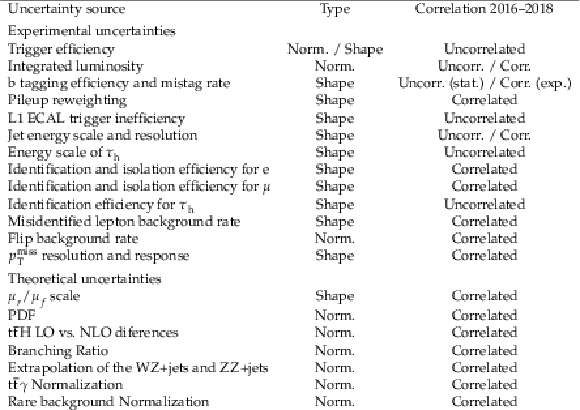
png pdf |
Table 5:
Summary of the uncertainty sources, their type, and their correlations across the three data-taking periods. Trigger efficiency uncertainty is taken as a shape or normalization systematic depending on the channel. |

png pdf |
Table 6:
One-dimensional confidence intervals at 68 and 95% CL for $ \kappa_{\mathrm{t}} $ (fixing $ \tilde{\kappa}_{\mathrm{t}} $ to the SM) and $ \tilde{\kappa}_{\mathrm{t}} $ (fixing $ \kappa_{\mathrm{t}} $ to the SM). The upper part of the table shows the expected limits while the lower part shows the observed limits. |

png pdf |
Table 7:
One-dimensional confidence intervals at 68 and 95% CL for $ \kappa_{\mathrm{t}} $ and $ \tilde{\kappa}_{\mathrm{t}} $. |
| Summary |
| A measurement of the charge-parity (CP) structure of the Yukawa coupling between the Higgs (H) boson and top quarks at tree level, when the H boson is produced in association with one (tH) or two (ttH) top quarks, is presented. The measurement is based on data collected in proton-proton collisions at $\sqrt{s} = $ 13 TeV by the CMS experiment at the CERN LHC, corresponding to an integrated luminosity of 138 fb$^{-1}$. The analysis targets events where the H boson decays to leptons and the top quark(s) decay either leptonically or hadronically. Separation of CP-even from CP-odd scenarios is achieved by applying machine learning techniques to final states characterized by the presence of at least two leptons. Two-dimensional confidence regions are set on ${\kappa_{\mathrm{t}}}$ and ${\tilde{\kappa}_{\mathrm{t}}}$ which are respectively the CP-even and CP-odd top-Higgs Yukawa coupling modifiers: one-dimensional confidence intervals are also set, constraining ${\kappa_{\mathrm{t}}}$ to be within ($-$1.09, $-$0.74) or (0.77, 1.30) and ${\tilde{\kappa}_{\mathrm{t}}}$ to be within ($-$1.4, 1.4) at 95% confidence level (CL). No significant CP-odd contribution is observed, and the corresponding fraction parameter is determined to be ${|{f_{\mathrm{CP}}^{\mathrm{H}\mathrm{t}\mathrm{t}}}|} =$ 0.59 with an interval of (0.24, 0.81) at 68% CL. The results are combined with previously published analyses covering the H $\to$ ZZ and H $\to\gamma\gamma$ decay modes. Two- and one-dimensional confidence regions are set on ${\kappa_{\mathrm{t}}}$ and ${\tilde{\kappa}_{\mathrm{t}}}$, constraining ${\kappa_{\mathrm{t}}}$ to be within (0.86, 1.26) and ${\tilde{\kappa}_{\mathrm{t}}}$ to be within ($-$1.07, 1.07) at 95% CL. The possibility of a CP-odd contribution is also investigated in the combination, yielding a best fit of ${|{f_{\mathrm{CP}}^{\mathrm{H}\mathrm{t}\mathrm{t}}}|} =$ 0.28 with an interval of ${|{f_{\mathrm{CP}}^{\mathrm{H}\mathrm{t}\mathrm{t}}}|} <$ 0.55 at 68% CL. The results are compatible with predictions for the standard model H boson. |
| Additional Figures | |

png pdf |
Additional Figure 1:
Output of the XGBOOST used for CP discrimination in 2$ \ell$SS+0$\tau_\mathrm{h} $ channel. The vertical bars represent the statistical uncertainty originating from the limited amount of simulated events. When not visible, the bars are smaller than the line width. |

png pdf |
Additional Figure 2:
Output of the XGBOOST used for CP discrimination in 3$ \ell$+0$\tau_\mathrm{h} $ channel. The vertical bars represent the statistical uncertainty originating from the limited amount of simulated events. When not visible, the bars are smaller than the line width. |

png pdf |
Additional Figure 3:
Output of the XGBOOST used for CP discrimination in 2$ \ell$SS+1$\tau_\mathrm{h} $ channel. The vertical bars represent the statistical uncertainty originating from the limited amount of simulated events. When not visible, the bars are smaller than the line width. |

png pdf |
Additional Figure 4:
Most important input variables to the XGBOOST used for CP discrimination in 2$ \ell$SS+1$\tau_\mathrm{h} $ channel. The vertical bars represent the statistical uncertainty originating from the limited amount of simulated events. When not visible, the bars are smaller than the line width. |

png pdf |
Additional Figure 4-a:
$M_{\mathrm{t\bar{t}H}}$, one of the most important input variables to the XGBOOST used for CP discrimination in 2$ \ell$SS+1$\tau_\mathrm{h} $ channel. The vertical bars represent the statistical uncertainty originating from the limited amount of simulated events. When not visible, the bars are smaller than the line width. |

png pdf |
Additional Figure 4-b:
Minimum $\Delta R_{\text{jet-leading lepton}}$, one of the most important input variables to the XGBOOST used for CP discrimination in 2$ \ell$SS+1$\tau_\mathrm{h} $ channel. The vertical bars represent the statistical uncertainty originating from the limited amount of simulated events. When not visible, the bars are smaller than the line width. |

png pdf |
Additional Figure 4-c:
Average $\Delta R_{\text{jet-jet}}$, one of the most important input variables to the XGBOOST used for CP discrimination in 2$ \ell$SS+1$\tau_\mathrm{h} $ channel. The vertical bars represent the statistical uncertainty originating from the limited amount of simulated events. When not visible, the bars are smaller than the line width. |
| References | ||||
| 1 | ATLAS Collaboration | Observation of a new particle in the search for the Standard Model Higgs boson with the ATLAS detector at the LHC | PLB 716 (2012) 1 | 1207.7214 |
| 2 | CMS Collaboration | Observation of a new boson at a mass of 125 GeV with the CMS experiment at the LHC | PLB 716 (2012) 30 | CMS-HIG-12-028 1207.7235 |
| 3 | CMS Collaboration | Search for resonances decaying to a pair of Higgs bosons in the $ \mathrm{b\overline{b}q\overline{q}'}\ell\nu $ final state in proton-proton collisions at $ \sqrt{s}= $ 13 TeV | JHEP 10 (2019) 125 | 1904.04193 |
| 4 | CMS Collaboration | Precise determination of the mass of the Higgs boson and tests of compatibility of its couplings with the standard model predictions using proton collisions at 7 and 8 TeV | EPJC 75 (2015) 212 | CMS-HIG-14-009 1412.8662 |
| 5 | CMS Collaboration | Combined measurements of Higgs boson couplings in proton--proton collisions at $ \sqrt{s}= $ 13 TeV | EPJC 79 (2019) 421 | CMS-HIG-17-031 1809.10733 |
| 6 | CMS Collaboration | A portrait of the Higgs boson by the CMS experiment ten years after the discovery | Nature 607 (2022) 60 | CMS-HIG-22-001 2207.00043 |
| 7 | ATLAS Collaboration | A detailed map of Higgs boson interactions by the ATLAS experiment ten years after the discovery | Nature 607 (2022) 52 | 2207.00092 |
| 8 | CMS Collaboration | Measurement of the top quark mass using proton-proton data at $ {\sqrt{(s)}}= $ 7 and 8 TeV | PRD 93 (2016) 072004 | CMS-TOP-14-022 1509.04044 |
| 9 | B. A. Dobrescu and C. T. Hill | Electroweak symmetry breaking via top condensation seesaw | PRL 81 (1998) 2634 | hep-ph/9712319 |
| 10 | R. S. Chivukula, B. A. Dobrescu, H. Georgi, and C. T. Hill | Top Quark Seesaw Theory of Electroweak Symmetry Breaking | PRD 59 (1999) 075003 | hep-ph/9809470 |
| 11 | D. Delepine, J. M. Gerard, and R. Gonzalez Felipe | Is the standard Higgs scalar elementary? | PLB 372 (1996) 271 | hep-ph/9512339 |
| 12 | CMS Collaboration | Search for the associated production of the Higgs boson with a top-quark pair | JHEP 09 (2014) 087 | CMS-HIG-13-029 1408.1682 |
| 13 | ATLAS Collaboration | Search for the Standard Model Higgs boson produced in association with top quarks and decaying into $ \mathrm{b}\overline{\mathrm{b}} $ in pp collisions at $ \sqrt{s}= $ 8 TeV with the ATLAS detector | EPJC 75 (2015) 349 | 1503.05066 |
| 14 | ATLAS Collaboration | Search for the Standard Model Higgs boson decaying into $ \mathrm{b}\overline{\mathrm{b}} $ produced in association with top quarks decaying hadronically in pp collisions at $ \sqrt{s}= $ 8 TeV with the ATLAS detector | JHEP 05 (2016) 160 | 1604.03812 |
| 15 | ATLAS Collaboration | Search for the associated production of the Higgs boson with a top quark pair in multilepton final states with the ATLAS detector | PLB 749 (2015) 519 | 1506.05988 |
| 16 | ATLAS Collaboration | Search for $ \mathrm{H} \to \gamma\gamma $ produced in association with top quarks and constraints on the Yukawa coupling between the top quark and the Higgs boson using data taken at 7 TeV and 8 TeV with the ATLAS detector | PLB 740 (2015) 222 | 1409.3122 |
| 17 | CMS Collaboration | Measurements of properties of the Higgs boson decaying into the four-lepton final state in pp collisions at $ \sqrt{s}= $ 13 TeV | JHEP 11 (2017) 047 | CMS-HIG-16-041 1706.09936 |
| 18 | ATLAS Collaboration | Evidence for the associated production of the Higgs boson and a top quark pair with the ATLAS detector | PRD 97 (2018) 072003 | 1712.08891 |
| 19 | ATLAS Collaboration | Search for the standard model Higgs boson produced in association with top quarks and decaying into a $ \mathrm{b}\overline{\mathrm{b}} $ pair in pp collisions at $ \sqrt{s} = $ 13 TeV with the ATLAS detector | PRD 97 (2018) 072016 | 1712.08895 |
| 20 | CMS Collaboration | Evidence for associated production of a Higgs boson with a top quark pair in final states with electrons, muons, and hadronically decaying $ \tau $ leptons at $ \sqrt{s} = $ 13 TeV | JHEP 08 (2018) 066 | CMS-HIG-17-018 1803.05485 |
| 21 | CMS Collaboration | Search for $ \mathrm{t}\overline{\mathrm{t}}\mathrm{H} $ production in the all-jet final state in proton-proton collisions at $ \sqrt{s}= $ 13 TeV | JHEP 06 (2018) 101 | CMS-HIG-17-022 1803.06986 |
| 22 | CMS Collaboration | Measurements of Higgs boson properties in the diphoton decay channel in proton-proton collisions at $ \sqrt{s} = $ 13 TeV | JHEP 11 (2018) 185 | CMS-HIG-16-040 1804.02716 |
| 23 | CMS Collaboration | Search for $ \mathrm{t}\overline{\mathrm{t}}\mathrm{H} $ production in the $ \mathrm{H}\to\mathrm{b}\overline{\mathrm{b}} $ decay channel with leptonic $ \mathrm{t} \overline{\mathrm{t}} $ decays in proton-proton collisions at $ \sqrt{s}= $ 13 TeV | JHEP 03 (2019) 026 | CMS-HIG-17-026 1804.03682 |
| 24 | ATLAS Collaboration | CP properties of Higgs boson interactions with top quarks in the $ \mathrm{t}\overline{\mathrm{t}}\mathrm{H} $ and $ \mathrm{t}\mathrm{H} $ processes using $ \mathrm{H}\to\gamma\gamma $ with the ATLAS detector | PRL 125 (2020) 061802 | 2004.04545 |
| 25 | CMS Collaboration | Measurements of $ \mathrm{t}\overline{\mathrm{t}}\mathrm{H} $ production and the CP structure of the Yukawa interaction between the Higgs boson and top quark in the diphoton decay channel | PRL 125 (2020) 061801 | CMS-HIG-19-013 2003.10866 |
| 26 | CMS Collaboration | Measurement of the Higgs boson production rate in association with top quarks in final states with electrons, muons, and hadronically decaying tau leptons at $ \sqrt{s} = $ 13 TeV | EPJC 81 (2021) 378 | CMS-HIG-19-008 2011.03652 |
| 27 | CMS Collaboration | Observation of $ \mathrm{t}\overline{\mathrm{t}}\mathrm{H} $ production | PRL 120 (2018) 231801 | CMS-HIG-17-035 1804.02610 |
| 28 | ATLAS Collaboration | Observation of Higgs boson production in association with a top quark pair at the LHC with the ATLAS detector | PLB 784 (2018) 173 | 1806.00425 |
| 29 | CMS Collaboration | Search for the associated production of a Higgs boson with a single top quark in proton-proton collisions at $ \sqrt{s}= $ 8 TeV | JHEP 06 (2016) 177 | CMS-HIG-14-027 1509.08159 |
| 30 | CMS Collaboration | Search for associated production of a Higgs boson and a single top quark in proton-proton collisions at $ \sqrt{s}= $ 13 TeV | PRD 99 (2019) 092005 | CMS-HIG-18-009 1811.09696 |
| 31 | CMS Collaboration | On the mass and spin-parity of the Higgs boson candidate via its decays to Z boson pairs | PRL 110 (2013) 081803 | CMS-HIG-12-041 1212.6639 |
| 32 | CMS Collaboration | Measurement of the properties of a Higgs boson in the four-lepton final state | PRD 89 (2014) 092007 | CMS-HIG-13-002 1312.5353 |
| 33 | CMS Collaboration | Constraints on the spin-parity and anomalous HVV couplings of the Higgs boson in proton collisions at 7 and 8 TeV | PRD 92 (2015) 012004 | CMS-HIG-14-018 1411.3441 |
| 34 | CMS Collaboration | Limits on the Higgs boson lifetime and width from its decay to four charged leptons | PRD 92 (2015) 072010 | CMS-HIG-14-036 1507.06656 |
| 35 | CMS Collaboration | Combined search for anomalous pseudoscalar HVV couplings in VH($ \mathrm{H}\to\mathrm{b}\overline{\mathrm{b}} $) production and $ \mathrm{H}\to\text{VV} $ decay | PLB 759 (2016) 672 | CMS-HIG-14-035 1602.04305 |
| 36 | CMS Collaboration | Constraints on anomalous Higgs boson couplings using production and decay information in the four-lepton final state | PLB 775 (2017) 1 | CMS-HIG-17-011 1707.00541 |
| 37 | CMS Collaboration | Constraints on anomalous HVV couplings from the production of Higgs bosons decaying to $ \tau $ lepton pairs | PRD 100 (2019) 112002 | CMS-HIG-17-034 1903.06973 |
| 38 | ATLAS Collaboration | Evidence for the spin-0 nature of the Higgs boson using ATLAS data | PLB 726 (2013) 120 | 1307.1432 |
| 39 | ATLAS Collaboration | Study of the spin and parity of the Higgs boson in diboson decays with the ATLAS detector | EPJC 75 (2015) 476 | 1506.05669 |
| 40 | ATLAS Collaboration | Test of CP invariance in vector-boson fusion production of the Higgs boson using the Optimal Observable Method in the ditau decay channel with the ATLAS detector | EPJC 76 (2016) 658 | 1602.04516 |
| 41 | ATLAS Collaboration | Measurement of inclusive and differential cross sections in the $ \mathrm{H} \to ZZ^* \to 4\ell $ decay channel in pp collisions at $ \sqrt{s}= $ 13 TeV with the ATLAS detector | JHEP 10 (2017) 132 | 1708.02810 |
| 42 | ATLAS Collaboration | Measurement of the Higgs boson coupling properties in the $ \mathrm{H}\to ZZ^{*} \to 4\ell $ decay channel at $ \sqrt{s} = $ 13 TeV with the ATLAS detector | JHEP 03 (2018) 095 | 1712.02304 |
| 43 | ATLAS Collaboration | Measurements of Higgs boson properties in the diphoton decay channel with 36 fb$ ^{-1} $ of pp collision data at $ \sqrt{s} = $ 13 TeV with the ATLAS detector | PRD 98 (2018) 052005 | 1802.04146 |
| 44 | CMS Collaboration | Constraints on anomalous Higgs boson couplings to vector bosons and fermions in its production and decay using the four-lepton final state | PRD 104 (2021) 052004 | CMS-HIG-19-009 2104.12152 |
| 45 | CMS Collaboration | Measurements of the Higgs boson width and anomalous HVV couplings from on-shell and off-shell production in the four-lepton final state | PRD 99 (2019) 112003 | CMS-HIG-18-002 1901.00174 |
| 46 | C. Zhang and S. Willenbrock | Effective-field-theory approach to top-quark production and decay | PRD 83 (2011) 034006 | 1008.3869 |
| 47 | R. Harnik et al. | Measuring CP violation in $ h \to \tau^+ \tau^- $ at colliders | PRD 88 (2013) 076009 | 1308.1094 |
| 48 | T. Ghosh, R. Godbole, and X. Tata | Determining the spacetime structure of bottom-quark couplings to spin-zero particles | PRD 100 (2019) 015026 | 1904.09895 |
| 49 | A. V. Gritsan, R. Röntsch, M. Schulze, and M. Xiao | Constraining anomalous Higgs boson couplings to the heavy flavor fermions using matrix element techniques | PRD 94 (2016) 055023 | 1606.03107 |
| 50 | CMS Collaboration | Analysis of the CP structure of the Yukawa coupling between the Higgs boson and $ \tau $ leptons in proton-proton collisions at $ \sqrt{s}= $ 13 TeV | JHEP 06 (2022) 012 | CMS-HIG-20-006 2110.04836 |
| 51 | CMS Collaboration | Constraints on anomalous Higgs boson couplings to vector bosons and fermions from the production of Higgs bosons using the $ \tau\tau $ final state | accepted by PRD, 2022 | 2205.05120 |
| 52 | ATLAS Collaboration | Constraints on Higgs boson properties using $ WW^{*}(\to \mathrm{e}\nu\mu\nu)\text{jj} $ production in 36.1 fb$ ^{-1} $ of $ \sqrt{s}= $ 13 TeV pp collisions with the ATLAS detector | 2109.13808 | |
| 53 | D. de Florian et al. | Handbook of LHC Higgs cross sections: 4. Deciphering the nature of the Higgs sector | CERN Report CERN-2017-002-M, 2016 link |
1610.07922 |
| 54 | ATLAS, CMS Collaboration | Combined Measurement of the Higgs Boson Mass in $ pp $ Collisions at $ \sqrt{s}= $ 7 and 8 TeV with the ATLAS and CMS Experiments | PRL 114 (2015) 191803 | 1503.07589 |
| 55 | K. Kondo | Dynamical likelihood method for reconstruction of events with missing momentum. 1: method and toy models | J. Phys. Soc. Jap. 57 (1988) 4126 | |
| 56 | K. Kondo | Dynamical likelihood method for reconstruction of events with missing momentum. 2: mass spectra for 2 $ \to $ 2 processes | J. Phys. Soc. Jap. 60 (1991) 836 | |
| 57 | CMS Collaboration | HEPData record for this analysis | link | |
| 58 | F. Demartin, F. Maltoni, K. Mawatari, and M. Zaro | Higgs production in association with a single top quark at the LHC | EPJC 75 (2015) 267 | 1504.00611 |
| 59 | CMS Collaboration | The CMS trigger system | JINST 12 (2017) P01020 | CMS-TRG-12-001 1609.02366 |
| 60 | CMS Collaboration | The CMS experiment at the CERN LHC | JINST 3 (2008) S08004 | |
| 61 | CMS Collaboration | Precision luminosity measurement in proton-proton collisions at $ \sqrt{s} = $ 13 TeV in 2015 and 2016 at CMS | EPJC 81 (2021) 800 | CMS-LUM-17-003 2104.01927 |
| 62 | CMS Collaboration | CMS luminosity measurement for the 2017 data-taking period at $ \sqrt{s} = $ 13 TeV | CMS Physics Analysis Summary, 2018 link |
CMS-PAS-LUM-17-004 |
| 63 | CMS Collaboration | CMS luminosity measurement for the 2018 data-taking period at $ \sqrt{s} = $ 13 TeV | CMS Physics Analysis Summary, 2019 link |
CMS-PAS-LUM-18-002 |
| 64 | F. Maltoni, G. Ridolfi, and M. Ubiali | b-initiated processes at the LHC: a reappraisal | JHEP 07 (2012) 022 | 1203.6393 |
| 65 | J. Alwall et al. | The automated computation of tree-level and next-to-leading order differential cross sections, and their matching to parton shower simulations | JHEP 07 (2014) 079 | 1405.0301 |
| 66 | J. Alwall et al. | Comparative study of various algorithms for the merging of parton showers and matrix elements in hadronic collisions | EPJC 53 (2008) 473 | 0706.2569 |
| 67 | P. Artoisenet, R. Frederix, O. Mattelaer, and R. Rietkerk | Automatic spin-entangled decays of heavy resonances in Monte Carlo simulations | JHEP 03 (2013) 015 | 1212.3460 |
| 68 | R. Frederix and S. Frixione | Merging meets matching in MC@NLO | JHEP 12 (2012) 061 | 1209.6215 |
| 69 | R. Frederix and I. Tsinikos | Subleading EW corrections and spin-correlation effects in $ t\bar{t}W $ multi-lepton signatures | EPJC 80 (2020) 803 | 2004.09552 |
| 70 | J. A. Dror, M. Farina, E. Salvioni, and J. Serra | Strong tW Scattering at the LHC | JHEP 01 (2016) 071 | 1511.03674 |
| 71 | P. Nason | A new method for combining NLO QCD with shower Monte Carlo algorithms | JHEP 11 (2004) 040 | hep-ph/0409146 |
| 72 | S. Frixione, P. Nason, and C. Oleari | Matching NLO QCD computations with parton shower simulations: the POWHEG method | JHEP 11 (2007) 070 | 0709.2092 |
| 73 | S. Alioli, P. Nason, C. Oleari, and E. Re | A general framework for implementing NLO calculations in shower Monte Carlo programs: the POWHEG box | JHEP 06 (2010) 043 | 1002.2581 |
| 74 | T. Sjöstrand et al. | An introduction to PYTHIA 8.2 | Comput. Phys. Commun. 191 (2015) 159 | 1410.3012 |
| 75 | CMS Collaboration | Extraction and validation of a new set of CMS PYTHIA 8 tunes from underlying-event measurements | EPJC 80 (2020) 4 | CMS-GEN-17-001 1903.12179 |
| 76 | CMS Collaboration | Investigations of the impact of the parton shower tuning in PYTHIA 8 in the modelling of $ \mathrm{t} \overline{\mathrm{t}} $ at $ \sqrt{s}= $ 8 and 13 TeV | Technical Report, 2016 CMS-PAS-TOP-16-021 |
CMS-PAS-TOP-16-021 |
| 77 | CMS Collaboration | Event generator tunes obtained from underlying event and multiparton scattering measurements | EPJC 76 (2016) 155 | CMS-GEN-14-001 1512.00815 |
| 78 | J. S. Gainer et al. | Exploring theory space with Monte Carlo reweighting | JHEP 10 (2014) 078 | 1404.7129 |
| 79 | O. Mattelaer | On the maximal use of Monte Carlo samples: re-weighting events at NLO accuracy | EPJC 76 (2016) 674 | 1607.00763 |
| 80 | GEANT4 Collaboration | GEANT 4---a simulation toolkit | NIM A 506 (2003) 250 | |
| 81 | J. Allison et al. | Recent developments in GEANT 4 | NIM A 835 (2016) 186 | |
| 82 | CMS Collaboration | Measurements of inclusive W and Z cross sections in pp collisions at $ \sqrt{s} = $ 7 TeV | JHEP 01 (2011) 080 | CMS-EWK-10-002 1012.2466 |
| 83 | CMS Collaboration | Jet energy scale and resolution in the CMS experiment in pp collisions at 8 TeV | JINST 12 (2017) P02014 | CMS-JME-13-004 1607.03663 |
| 84 | CMS Collaboration | Identification of heavy-flavour jets with the CMS detector in pp collisions at 13 TeV | JINST 13 (2018) P05011 | CMS-BTV-16-002 1712.07158 |
| 85 | CMS Collaboration | Performance of reconstruction and identification of $ \tau $ leptons decaying to hadrons and $ \nu_{\tau} $ in pp collisions at $ \sqrt{s} = $ 13 TeV | JINST 13 (2018) P10005 | CMS-TAU-16-003 1809.02816 |
| 86 | CMS Collaboration | Performance of missing transverse momentum reconstruction in proton-proton collisions at $ \sqrt{s} = $ 13 TeV using the CMS detector | JINST 14 (2019) P07004 | CMS-JME-17-001 1903.06078 |
| 87 | F. Demartin et al. | $ \mathrm{t}\mathrm{W}\mathrm{H} $ associated production at the LHC | EPJC 77 (2017) 34 | 1607.05862 |
| 88 | J. M. Campbell, R. K. Ellis, and C. Williams | Vector boson pair production at the LHC | JHEP 07 (2011) 018 | 1105.0020 |
| 89 | CMS Collaboration | Identification of hadronic tau lepton decays using a deep neural network | CMS-TAU-20-001 2201.08458 |
|
| 90 | M. Cacciari, G. P. Salam, and G. Soyez | The anti-$ k_{\mathrm{T}} $ jet clustering algorithm | JHEP 04 (2008) 063 | 0802.1189 |
| 91 | CMS Collaboration | Particle-flow reconstruction and global event description with the CMS detector | JINST 12 (2017) P10003 | CMS-PRF-14-001 1706.04965 |
| 92 | M. Cacciari, G. P. Salam, and G. Soyez | The catchment area of jets | JHEP 04 (2008) 005 | 0802.1188 |
| 93 | CMS Collaboration | Technical proposal for the Phase-II upgrade of the Compact Muon Solenoid | CMS Technical Proposal CERN-LHCC-2015-010, CMS-TDR-15-02, 2015 CDS |
|
| 94 | E. Bols et al. | Jet Flavour Classification Using DeepJet | JINST 15 (2020) P12012 | 2008.10519 |
| 95 | CMS Collaboration | Performance of the DeepJet b tagging algorithm using 41.9/fb of data from proton-proton collisions at 13 TeV with Phase 1 CMS detector | CMS Detector Performance Note CMS-DP-2018-058, 2018 CDS |
|
| 96 | T. Hastie, R. Tibshirani, and J. Friedman | The elements of statistical learning | Springer-Verlag, second edition, ISBN~978-0-387-84858-7, 2013 link |
|
| 97 | L. Breiman, J. Friedman, R. Olshen, and C. Stone | Classification and regression trees | Wadsworth, . ISBN~978-041418, 1984 | |
| 98 | J. Brehmer, K. Cranmer, G. Louppe, and J. Pavez | Constraining effective field theories with machine learning | PRL 121 (2018) 111801 | 1805.00013 |
| 99 | CMS Collaboration | Performance of electron reconstruction and selection with the CMS detector in proton-proton collisions at $ \sqrt{s} = $ 8 TeV | JINST 10 (2015) P06005 | CMS-EGM-13-001 1502.02701 |
| 100 | T. Chen and C. Guestrin | XGBoost: A scalable tree boosting system | link | 1603.02754 |
| 101 | F. Demartin et al. | Higgs characterisation at NLO in QCD: CP properties of the top-quark Yukawa interaction | EPJC 74 (2014) 3065 | 1407.5089 |
| 102 | ATLAS and CMS Collaborations, and LHC Higgs Combination Group | Procedure for the LHC Higgs boson search combination in Summer 2011 | Technical Report CMS-NOTE-2011-005, ATL-PHYS-PUB-2011-11, 2011 | |
| 103 | R. J. Barlow and C. Beeston | Fitting using finite Monte Carlo samples | Comput. Phys. Commun. 77 (1993) 219 | |
| 104 | CMS Collaboration | Measurement of the inelastic proton-proton cross section at $ \sqrt{s}= $ 13 TeV | JHEP 07 (2018) 161 | CMS-FSQ-15-005 1802.02613 |
| 105 | CMS Collaboration | Performance of the CMS Level-1 trigger in proton-proton collisions at $ \sqrt{s} = $ 13 TeV | JINST 15 (2020) P10017 | CMS-TRG-17-001 2006.10165 |
| 106 | S. Heinemeyer et al. | Handbook of LHC Higgs cross sections: 3. Higgs properties | CERN Report CERN-2013-004, 2013 link |
1307.1347 |
| 107 | M. Cacciari et al. | The $ \mathrm{t}\overline{\mathrm{t}} $ cross-section at 1.8 TeV and 1.96 TeV: a study of the systematics due to parton densities and scale dependence | JHEP 04 (2004) 068 | hep-ph/0303085 |
| 108 | S. Catani, D. de Florian, M. Grazzini, and P. Nason | Soft gluon resummation for Higgs boson production at hadron colliders | JHEP 07 (2003) 028 | hep-ph/0306211 |
| 109 | R. Frederix et al. | Four-lepton production at hadron colliders: MadGraph-5_aMC@NLO predictions with theoretical uncertainties | JHEP 02 (2012) 099 | 1110.4738 |
| 110 | J. Butterworth et al. | PDF4LHC recommendations for LHC Run 2 | JPG 43 (2016) 023001 | 1510.03865 |

|
Compact Muon Solenoid LHC, CERN |

|

|

|

|

|

|